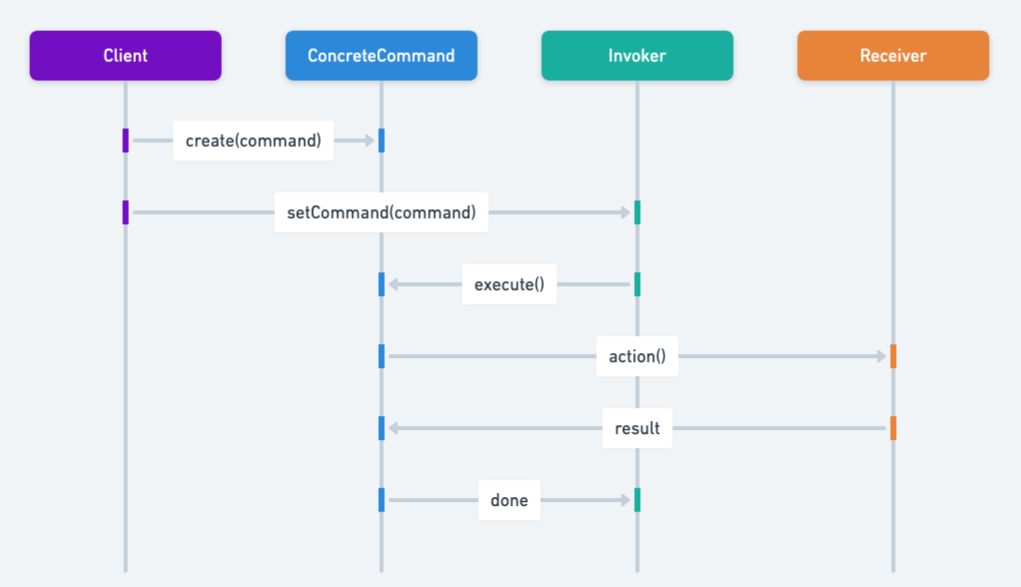Command Pattern in Java: Empowering Flexible Command Execution
Also known as
- Action
- Transaction
Intent of Command Design Pattern
The Command design pattern is a behavioral pattern used in Java programming. It encapsulates a request as an object, allowing for parameterization of clients with queues, requests, and operations. This pattern also supports undoable operations, enhancing flexibility in managing and executing commands.
Detailed Explanation of Command Pattern with Real-World Examples
Real-world example
Imagine a smart home system where you can control devices such as lights, thermostats, and security cameras through a central application. Each command to operate these devices is encapsulated as an object, enabling the system to queue, execute sequentially, and undo commands if necessary. This approach decouples control logic from device implementation, allowing easy addition of new devices or features without altering the core application. This flexibility and functionality illustrate the practical application of the Command design pattern in Java programming.
In plain words
Storing requests as command objects allows performing an action or undoing it at a later time.
Wikipedia says
In object-oriented programming, the command pattern is a behavioral design pattern in which an object is used to encapsulate all information needed to perform an action or trigger an event at a later time.
Sequence diagram

Programmatic Example of Command Pattern in Java
In the Command pattern, objects are used to encapsulate all information needed to perform an action or trigger an event at a later time. This pattern is particularly useful for implementing undo functionality in applications.
In our example, a Wizard casts spells on a Goblin. Each spell is a command object that can be executed and undone, demonstrating the core principles of the Command pattern in Java. The spells are executed on the goblin one by one. The first spell shrinks the goblin and the second makes him invisible. Then the wizard reverses the spells one by one. Each spell here is a command object that can be undone.
Let's start from the Wizard class.
@Slf4j
public class Wizard {
private final Deque<Runnable> undoStack = new LinkedList<>();
private final Deque<Runnable> redoStack = new LinkedList<>();
public Wizard() {
}
public void castSpell(Runnable runnable) {
runnable.run();
undoStack.offerLast(runnable);
}
public void undoLastSpell() {
if (!undoStack.isEmpty()) {
var previousSpell = undoStack.pollLast();
redoStack.offerLast(previousSpell);
previousSpell.run();
}
}
public void redoLastSpell() {
if (!redoStack.isEmpty()) {
var previousSpell = redoStack.pollLast();
undoStack.offerLast(previousSpell);
previousSpell.run();
}
}
@Override
public String toString() {
return "Wizard";
}
}Next, we have the Goblin who's the Target of the spells.
@Slf4j
@Getter
@Setter
public abstract class Target {
private Size size;
private Visibility visibility;
public void printStatus() {
LOGGER.info("{}, [size={}] [visibility={}]", this, getSize(), getVisibility());
}
public void changeSize() {
var oldSize = getSize() == Size.NORMAL ? Size.SMALL : Size.NORMAL;
setSize(oldSize);
}
public void changeVisibility() {
var visible = getVisibility() == Visibility.INVISIBLE
? Visibility.VISIBLE : Visibility.INVISIBLE;
setVisibility(visible);
}
}public class Goblin extends Target {
public Goblin() {
setSize(Size.NORMAL);
setVisibility(Visibility.VISIBLE);
}
@Override
public String toString() {
return "Goblin";
}
}Finally, we can show the full example of Wizard casting spells.
public static void main(String[] args) {
var wizard = new Wizard();
var goblin = new Goblin();
goblin.printStatus();
wizard.castSpell(goblin::changeSize);
goblin.printStatus();
wizard.castSpell(goblin::changeVisibility);
goblin.printStatus();
wizard.undoLastSpell();
goblin.printStatus();
wizard.undoLastSpell();
goblin.printStatus();
wizard.redoLastSpell();
goblin.printStatus();
wizard.redoLastSpell();
goblin.printStatus();
}Here's the program output:
20:13:38.406 [main] INFO com.iluwatar.command.Target -- Goblin, [size=normal] [visibility=visible]
20:13:38.409 [main] INFO com.iluwatar.command.Target -- Goblin, [size=small] [visibility=visible]
20:13:38.409 [main] INFO com.iluwatar.command.Target -- Goblin, [size=small] [visibility=invisible]
20:13:38.409 [main] INFO com.iluwatar.command.Target -- Goblin, [size=small] [visibility=visible]
20:13:38.409 [main] INFO com.iluwatar.command.Target -- Goblin, [size=normal] [visibility=visible]
20:13:38.409 [main] INFO com.iluwatar.command.Target -- Goblin, [size=small] [visibility=visible]
20:13:38.409 [main] INFO com.iluwatar.command.Target -- Goblin, [size=small] [visibility=invisible]When to Use the Command Pattern in Java
The Command design pattern is applicable when you need to parameterize objects with actions, support undo operations, or structure a system around high-level operations built on primitive ones. It is commonly used in GUI buttons, database transactions, and macro recording.
Use the Command pattern when you want to:
- Parameterize objects with actions to perform, offering an object-oriented alternative to callbacks found in procedural languages. Commands can be registered and executed later.
- Specify, queue, and execute requests at different times, allowing commands to exist independently of the original request and even be transferred across processes.
- Support undo functionality, where the Command’s execute operation stores state and includes an un-execute operation to reverse previous actions. This allows for unlimited undo and redo capabilities by maintaining a history list.
- Log changes to reapply them after a system crash. By adding load and store operations to the Command interface, you can maintain a persistent log of changes and recover by reloading and re-executing commands from this log.
- Structure a system around high-level operations built on primitive operations, which is common in transaction-based systems. The Command pattern models transactions by providing a common interface for invoking and extending operations.
- Keep a history of requests.
- Implement callback functionality.
- Implement undo functionality.
Real-World Applications of Command Pattern in Java
- GUI Buttons and menu items in desktop applications.
- Operations in database systems and transactional systems that support rollback.
- Macro recording in applications like text editors and spreadsheets.
- java.lang.Runnable
- org.junit.runners.model.Statement
- Netflix Hystrix
- javax.swing.Action
Benefits and Trade-offs of Command Pattern
Benefits:
- Decouples the object that invokes the operation from the one that knows how to perform it.
- It's easy to add new Commands, because you don't have to change existing classes.
- You can assemble a set of commands into a composite command.
Trade-offs:
- Increases the number of classes for each individual command.
- Can complicate the design by adding multiple layers between senders and receivers.
Related Java Design Patterns
- Composite: Commands can be composed using the Composite pattern to create macro commands.
- Memento: Can be used for implementing undo mechanisms.
- Observer: The pattern can be observed for changes that trigger commands.